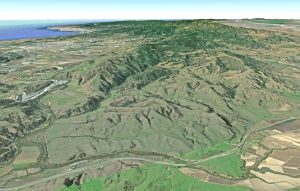The Importance of Sargent Ranch
The Amah Mutsun Tribal Band know it as Juristac, a sacred place where healing ceremonies and dances took place for centuries. The public knows it as Sargent Ranch, 6,500 acres of nearly pristine open space at the tail end of the Santa Cruz Mountains, where the foothills slope down towards the broad agricultural fields south of Gilroy. To the Debt Acquisition Company of America (DACA), the property’s owner, it is a potential sand and gravel quarry.
Committee for Green Foothills has a decades-long history of fighting for Sarg ent Ranch, and our commitment to preserving this culturally and ecologically unique site has not wavered. The land includes serpentine grasslands, oak savannah, sycamore riparian woodlands, and a unique natural tar spring. It’s home to threatened and endangered species such as steelhead trout, California red-legged frogs, and California tiger salamanders. Sargent Ranch is also a critical wildlife route, linking the Santa Cruz Mountains with the Diablo Range to the east and the Gabilan Range to the south. Together with Coyote Valley, 25 miles to the north, it is the only viable path for wildlife to migrate into and out of the Santa Cruz Mountains.
ent Ranch, and our commitment to preserving this culturally and ecologically unique site has not wavered. The land includes serpentine grasslands, oak savannah, sycamore riparian woodlands, and a unique natural tar spring. It’s home to threatened and endangered species such as steelhead trout, California red-legged frogs, and California tiger salamanders. Sargent Ranch is also a critical wildlife route, linking the Santa Cruz Mountains with the Diablo Range to the east and the Gabilan Range to the south. Together with Coyote Valley, 25 miles to the north, it is the only viable path for wildlife to migrate into and out of the Santa Cruz Mountains.
The native Amah Mutsun ceremonies here were often attended by other tribal groups in the region. Juristac’s nearly pristine state, amidst so many irreparably altered Amah Mutsun living and gathering places, makes it practically unique in its importance and in the urgency of its preservation.
Committee for Green Foothills has opposed Sargent Ranch development proposals since 1993, including a plan to build four “villages” of over 12,000 residents, a proposal for two golf courses, and a luxury residential development. Along with other environmental groups, we have fought to stop the urban development floodgates from opening on Santa Clara County ranchlands. Several years later, the owner of Sargent Ranch declared bankruptcy, and the land was acquired by creditors, including DACA.
Newest Threat: A Quarry Proposal
DACA has applied for a permit to operate a sand and gravel quarry on Sargent Ranch. The proposed quarry would cover over 300 acres of hillsides and grasslands and excavate about 40 million tons of sand and gravel over its 30-year life. Where there are currently grassy hillsides and oak savannah, there would instead be 200-foot-deep quarry pits, a 14-acre processing plant, piles of “waste” rocks and dirt, a 1.6-mile-long conveyor belt to transport the quarried material, new roads for trucks, and a bridge over Tar Springs Creek. Operators would pump about 86,000 gallons of groundwater every day to work the processing plant and control quarry dust. The noise, lights, roads, fences, and disruption of the landscape could negatively affect wildlife migration, and erosion and runoff from quarry operations, roads, and waste piles could contaminate both Sargent Creek and Tar Springs Creek.
In addition to the likely environmental damage, the potential for cultural damage for the Amah Mutsun is unparalleled. Destruction of this ancient landscape is a disruption of the spiritual integrity of the land, something impossible to quantify or mitigate. It should be unthinkable to destroy even a small portion of an Amah Mutsun sacred site for any reason, let alone in order to obtain and process sand and gravel, easily available at other sites.
Conservation and land trust organizations have expressed interest in acquiring and preserving Sargent Ranch. However, DACA has refused to sell the property, preferring to pursue the proposed quarry operation. Committee for Green Foothills continues to work with partners to achieve open space protection for the entire 6,500-acre property.
What We Are Doing and How You Can Help
Santa Clara County is expected to release the Draft Environmental Impact Report (DEIR) on the Sargent Ranch quarry proposal this soon. Committee for Green Foothills will submit comments on the DEIR and work to bring the importance of this issue to the attention of county decisionmakers. Please help us by signing up for our email notifications, so that you’ll know when you can submit comments to the County or attend meetings to show support for preserving this unique landscape.

Leave a Reply